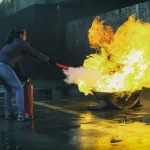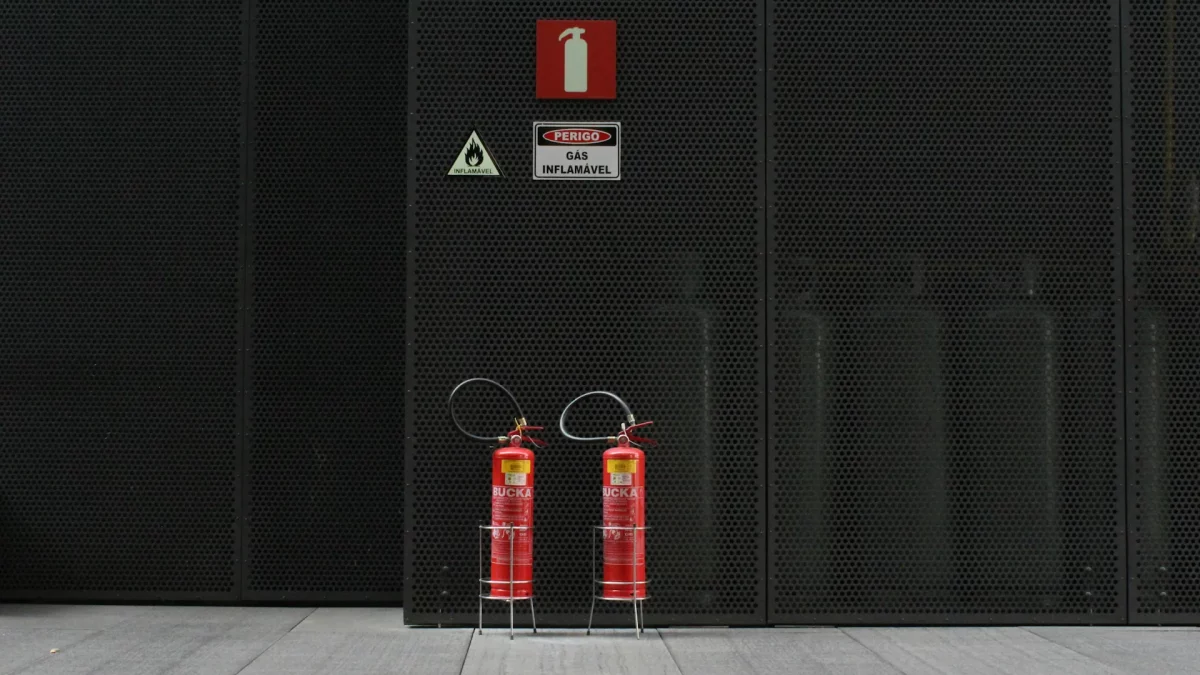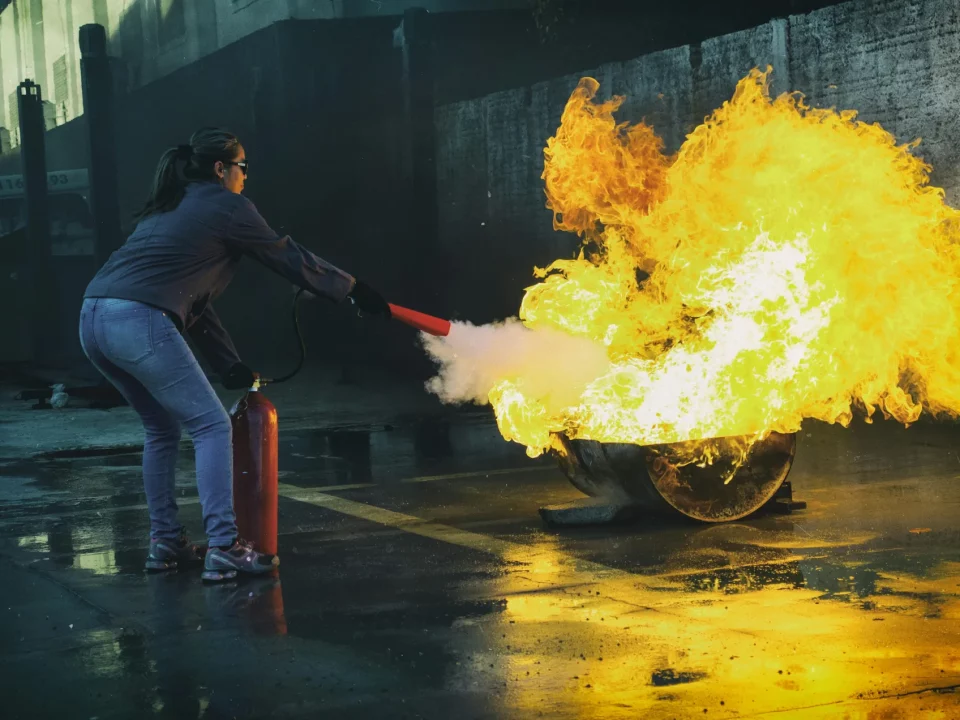Comparative 2025: Which first aid course should you choose between BLS-AED-SRC, IAS 1 and IAS 2?
02/10/2024
What are the different types of fire and how do you extinguish them?”
24/06/2025A fire can break out at any time in a company: a short-circuit, an overloaded piece of equipment, human error… In these situations, every second counts. By reacting quickly, you can limit the damage, protect your colleagues and sometimes even save lives.
But when faced with flames, many people hesitate: which extinguisher should I use? How to handle it? Where to aim it? This guide gives you the keys to understanding, choosing and using an extinguisher in complete safety.
Whether you’re an employee, HSE manager or company director, this knowledge is an essential complement to any fire safety training. Because when faced with fire, improvisation has no place.
Why knowing how to use a fire extinguisher can save lives
In the event of a fire, the first few minutes are decisive. An incipient fire can still be contained with a portable extinguisher, but without rapid intervention, it can turn into a major disaster.
Mastering the use of a fire extinguisher isn’t just a technical reflex: it’s an act of prevention and responsibility. In the workplace, it makes it possible to:
- to reduce the risk of flames spreading before help arrives;
- to protect employees, visitors and infrastructure;
- effectively meet the requirements of safety standards (in particular CFST directive 6508).
Simple gestures can make all the difference. It’s just a question of knowing what they are and applying them without panicking.
The different types of extinguisher and their use
Not all extinguishers are created equal. Each model is designed to extinguish a specific type of fire. Knowing these differences is essential if you are to intervene effectively and safely.
Water extinguisher (type A)
- Use: fire on solid materials (paper, wood, fabric).
- Benefits: highly effective against slow combustion.
- Caution: never use it over an electric fire.
Foam extinguisher (type AB)
- Use: solid fires + flammable liquid fires (petrol, solvents).
- Particularity: isolates the fuel from oxygen with a smothering foam.
CO₂ extinguisher (type B)
- Use: electrical fires and flammable liquids.
- Benefits: clean (no residue), effective on electronic equipment.
- Caution: risk of cold burns, requires good ventilation.
Powder extinguisher (ABC type)
- Use: versatile – solids, liquids, gases.
- Particularity: suitable for vehicle, industrial plant and gas fires.
- Disadvantage: messy, but very powerful.
Steps for using an extinguisher in a real-life situation
Dealing with a fire requires calm and method. Here are the steps to follow to use an extinguisher correctly:
1. Assess the situation
Before any work is carried out, make sure that :
- the fire is small and contained;
- you have the right type of extinguisher;
- There is an emergency exit nearby.
2. Remove the pin from the extinguisher
Pull the safety pin to release the release handle. Hold the extinguisher firmly by the handle.
3. Briefly test the device
Point the nozzle away from the fire and press lightly to test the jet. This checks that the extinguisher is working properly.
4. Aim for the base of the flames
Stand at a safe distance (2 to 3 metres) and aim the nozzle at the base of the fire, never at the flames themselves.
5. Sweep sideways
Squeeze the trigger and sweep from left to right at the base of the fire. Continue until the fire is completely extinguished or the appliance is exhausted.
Mistakes to avoid when using an extinguisher
Not identifying the type of fire
Using the wrong extinguisher can make the fire worse. For example, a water extinguisher on an electrical fire is dangerous.
Find our guide torecognising the type of fire for sure.
Aim for the flames instead of the base
Flames alone will not extinguish a fire. You have to cut off the source of combustion at the base to be effective.
Getting too close to the fireplace
A fire can intensify suddenly. Keeping a safe distance allows you to act while remaining protected.
Forget the alert
Using an extinguisher does not replace calling for help. In Switzerland, you should always dial 118 as soon as the fire breaks out.
Turning your back on fire
Even if the fire appears to be under control, it can start up again. Always withdraw carefully, keeping an eye on the fire.
Why training in the use of fire extinguishers is essential
Improving responsiveness to emergencies
Fire training teaches the right reflexes: how to spot the type of fire quickly, choose the right extinguisher and use it without hesitation. This mastery can make the difference between a controlled incident and a major disaster.
Reducing risks to yourself and others
With training, you can intervene safely, without putting yourself in danger or making the situation worse. You’ll also protect your colleagues, customers and family by limiting smoke, burns and chaotic evacuations.
Complying with legal obligations
In Switzerland, companies must train a certain number of employees in firefighting, in particular in accordance with the AEAI and CFST standards. Training with SafetyFirst will ensure regulatory compliance and reinforce your organisation’s safety culture.
Conclusion: using a fire extinguisher is vital and accessible
Knowing how to use a fire extinguisher is much more than learning the theory: it’s acquiring a decisive skill for intervening quickly and avoiding a disaster. This seemingly simple act needs to be repeated, understood and integrated through certified fire training.
At SafetyFirst, our in-company training courses in French-speaking Switzerland prepare you to deal with emergency situations methodically, calmly and effectively.
For further reading, see also
- Emergency evacuation training → to structure a quick and safe evacuation.
- Initial occupational health and safety audit → to assess the fire-related risks in your business.
FAQ: everything you need to know about using an extinguisher
How do you know which extinguisher to use depending on the type of fire?
Each extinguisher is designed for one type of fire:
Solid material fires (class A) → water or foam extinguisher.
Liquid fires (class B) → foam or powder extinguisher.
Electrical fires → CO₂ or powder extinguisher.
Can an extinguisher be used without training?
Theoretically, yes, but incorrect handling can be dangerous. Training teaches you how to react effectively without endangering people or property.
Where are fire extinguishers located in a company?
They must be visible, easily accessible and located near exits in high-risk areas (kitchen, workshop, etc.). Their location is regulated.
When should an extinguisher be serviced?
A fire extinguisher must be checked every year by an approved professional, and serviced every 5 years (or more often, depending on the model).
How long does an extinguisher last?
A fire extinguisher generally has a lifespan of 10 to 20 years, depending on its type and regular maintenance.



